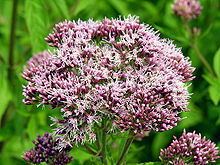Higher classification Daisy family | Subfamily Asteroideae Scientific name Eupatorium Rank Genus | |
 | ||
Lower classifications Common boneset, Eupatorium cannabinum, Eupatorium fortunei, Eupatorium capillifolium, Eupatorium serotinum | ||
Minnesota native plant sweet joe pye weed eupatorium purpureum
Eupatorium is a genus of flowering plants in the aster family, Asteraceae, containing from 36 to 60 species depending on the classification system. Most are herbaceous perennial plants growing to 0.5–3 m tall. A few are shrubs. The genus is native to temperate regions of the Northern Hemisphere. Most are commonly called bonesets, thoroughworts or snakeroots. The genus is named for Mithridates Eupator, king of Pontus.
Contents
- Minnesota native plant sweet joe pye weed eupatorium purpureum
- Flowering plant video library boneset eupatorium vf
- Systematics and taxonomy
- Uses
- Medical use
- North America
- Europe
- Asia
- Moved to other genera
- References

Flowering plant video library boneset eupatorium vf
Systematics and taxonomy

Eupatorium has at times been held to contain as many as 800 species, but many of these have been moved (at least by some authors) to other genera, including Ageratina, Chromolaena, Condylidium, Conoclinium, Critonia, Cronquistianthus, Eutrochium, Fleischmannia, Flyriella, Hebeclinium, Koanophyllon, Mikania, and Tamaulipa.
The classification of the tribe Eupatorieae, including species placed in Eupatorium in the present or past, is an area of ongoing research, so further changes are likely. What seems fairly certain by now is that there is a monophyletic group containing Eupatorium (about 42 species of white flowered plants in North America, Europe and Asia, but not South America) and the Joe-pye weeds (Eutrochium), and possibly others.
Uses
Eupatorium are grown as ornamental plants, in particular in Asia. A number of popular ornamental plants formerly included in Eupatorium have been moved to other genera, such as Bartlettina and Conoclinium.
Tobacco leaf curl virus is a pathogen occasionally affecting plants of this genus. The foliage is eaten by some Lepidoptera larvae, including those of Orthonama obstipata (The Gem).
Medical use
The common names for the plants are all based on the previous usage of one species, Eupatorium perfoliatum, as an herbal medicine. Despite its name, boneset is not used to treat broken bones, instead the common name apparently derives from the herb's use to treat dengue fever, which was also called breakbone fever because of the pain that it caused. The name thoroughwort also comes from Eupatorium perfoliatum, and refers to the perfoliate leaves, in which the stem appears to pierce the leaf (i.e. go through, note that in older usage "thorough" was not distinguished from "through", compare for example the word thoroughfare).
Boneset, although poisonous to humans and grazing livestock, has been used in folk medicine, for instance to excrete excess uric acid which causes gout. Caution is advised when using boneset, since it contains toxic compounds that can cause liver damage. Side effects include muscular tremors, weakness, and constipation; overdoses may be deadly.
